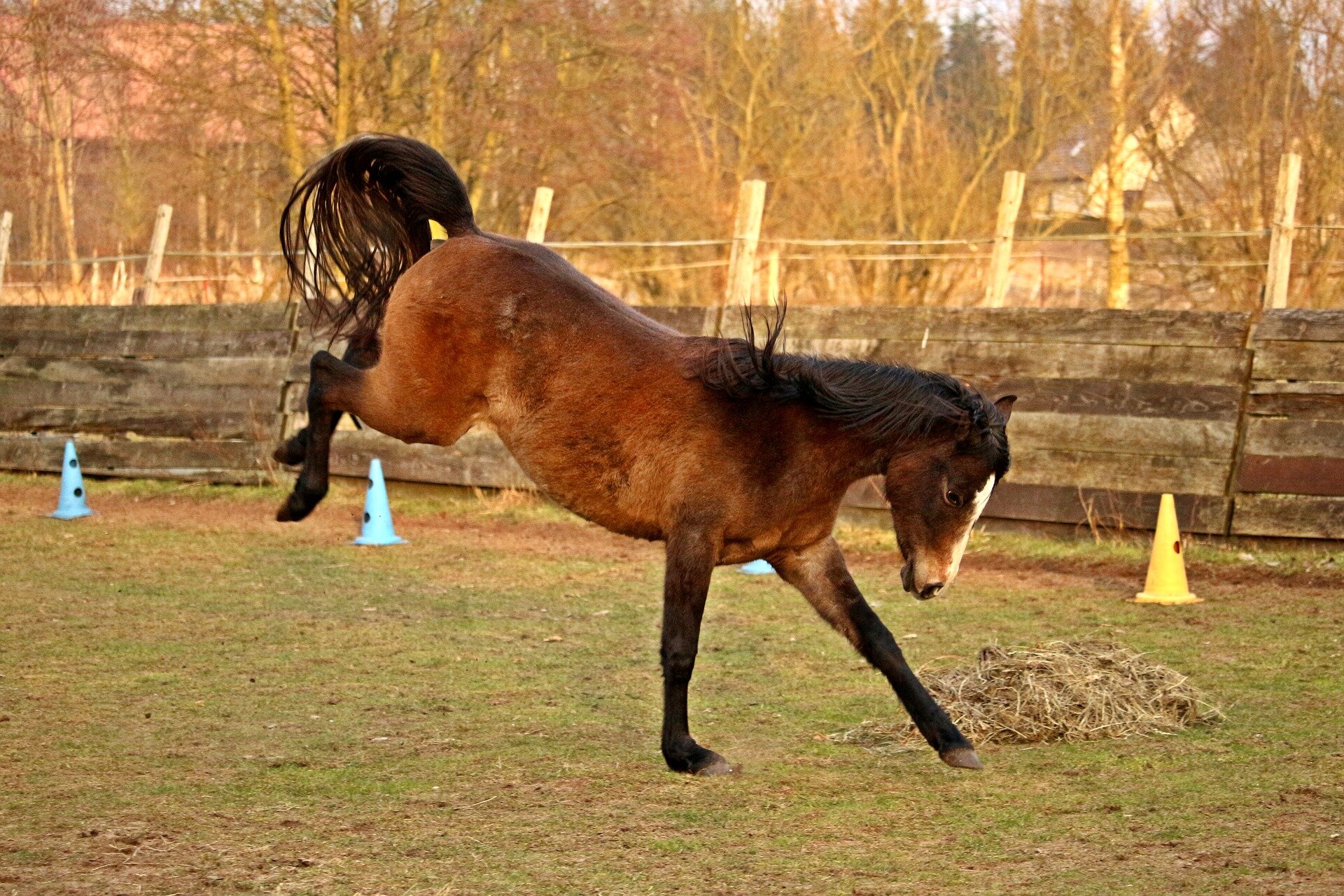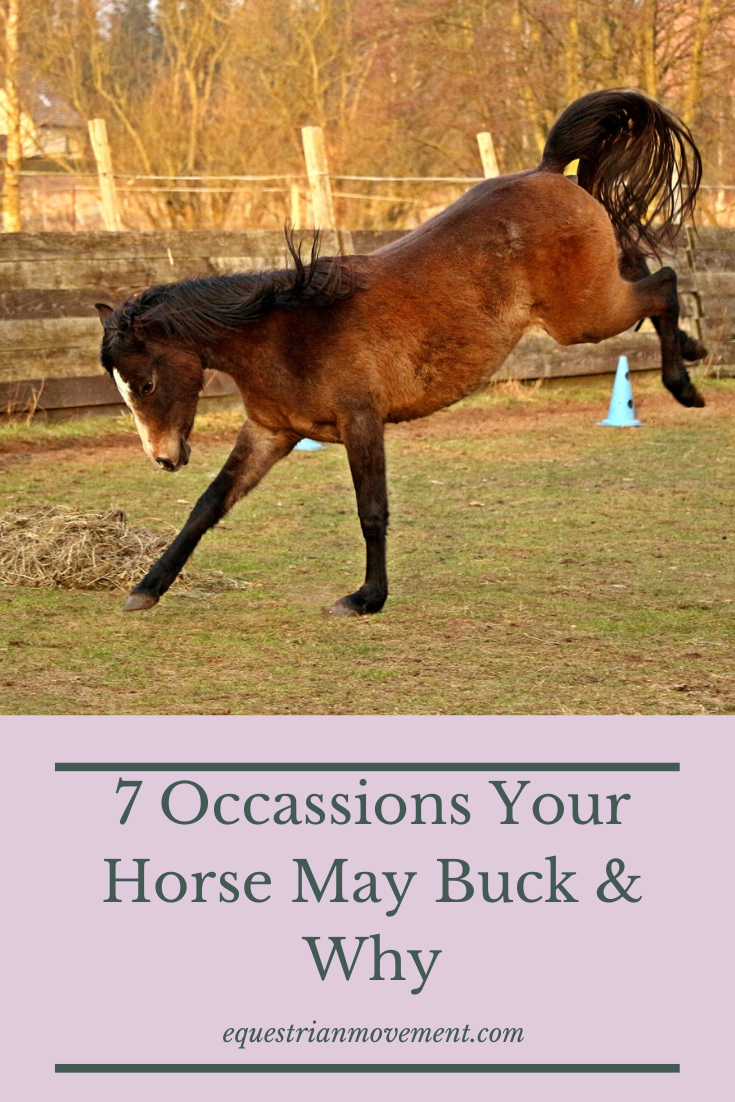Why does my horse buck? 7 Common Occassions & Their Cause
While a normal behaviour, it can be dangerous for us. Learn about the most common times horses buck and why they are doing it.
Horses bucking is a very normal and natural horse behaviour.
However, we don’t really want them doing it when we are handling or riding them because we can get hurt.
There are a couple of different types of bucking our horses can do as well. Just a little kick out in protest to your ask, through to a full out bronco ride that doesn’t stop until they get you off.
Knowing the type of bucking your horse is doing can help you to problem solve and understand what they need to not buck.
1. Bucking when mounting
If you are too scared to mount your horse because they take of bucking you will most likely need a breaker to work with your horse. There are a couple of reasons for this behaviour.
Poor mounting technique has meant that being mounted has hurt for them. Digging your toes into their ribs, twisting the saddle as you mount, pulling the saddle over and pulling and clambering your way up their back.
Sore back. The twist and the pull of climbing up into the saddle aggravates an already sore back
Girthy. If they are muscle sore around the girth, the way the girth pulls as you twist and pull yourself into the saddle can hurt
Saddle doesn’t fit
Memory of previous pain from being mounted
Poor initial experience of breaking. A horse doesn’t need to be bucked out to accept the saddle and rider. They do need to get used to moving with the restriction of the girth around the ribs and the rider moving and wobbling around on the their back.
Topline and their back not being conditioned to support the weight of the rider.
Thumping or sitting heavy into the saddle.
Any of these problems will also come up as you are just riding. For example the first few steps off in walk trigger a bronco outburst, the transition to trot, just a simple turn. Any time the horse unexpectable and unexplainably tacks off in a broncing fit these things need to be addressed.
2. Bucking when putting your heels in or touching the flank.
It is important that you know that the flank is a very sensitive area for the horse. It is literally where rodeo riders tie a rope to make a horse buck.
This is also the most common place for riders to swing their leg into when they lose their balance, especially in they are gripping with the knee. Swinging your heel into your horse flank and gripping can be an auto eject button on a lot of horses.
Being an unbalanced, bouncy rider on a green, novice horse or a horse that is even the slightest bit sore through their back, nervous, anxious horses and horses that are a little intolerant. It takes a very special horse to look after an inexperienced rider - that’s why a lot of riding school horses and trail horses are worth their weight in gold. They don’t react to unbalanced riders. Working on your core and riding independently of your horse is and important skill to develop as a horse riding that wants to care for their horse and to help kicking or bucking out.
3. Horse bucks when excited.
A horse that can’t control its emotions can’t control its behaviour.
We can often see this kind of bucking when we let our horse out for a big gallop or if other horses are loose galloping around and playing and our horse wants to join in. They can also buck on a gallop because they’ve lost their balance and trying to catch it. This one just takes time correcting to let our horse know what is appropriate under saddle and what isn’t.
4. Horse bucks into canter when asked to canter
If your horse only really bucks going into canter this is a pretty strong sign of them being cold backed or working hollow and tight through their back.
With the way the trot strides work in a diagonal pair, they can work with their head down in a frame and not properly warm their back up.
Because they canter has a naturally roundedness and lift through the back, if they’re back isn’t warmed up properly they will use the transition to canter to stretch their back and jump into it. If you warm up the canter on the lunge before you ride it probably won’t happen under saddle. The may also baulk or kick out after poles or jumps because this also encourages them to use their back.
5. Horse bucks when asked to move forward
Bucking when asking to move forward the horse has commonly established an aversion to leg pressure and gone sour on their working.
Spicing it up by hacking out, having them fit for their job and doing other groundwork exercises can help. Spurs will make it worse and the whip also usually makes it worse.
6. Horse bucks after jump
As with bucking into canter, horses that buck after the jump are generally cold backed and need their back well warmed up. They sometimes also do it if they are scared of the jump fill.
I have had some horses that only buck after a jump if they clip the rail, so that could be either frustration with themselves for touching it or giving themselves a fright.
7. Horse bucks on the lunge
This one I’m less worried about.
If my horse has some bucks in his system and needs to warm his back up, I want him to do it on the lunge and not in the saddle. I still don’t want them to be crazy and out of control, but I’m ok with them kicking their legs around a bit. If I have the right facilities and may also free lunge and let them have a good run and a buck if they really want to play, get the crazies out of their system or want a good stretch.
Once we have identified the when of the bucking, we can start to look deeper into the why, and then start to work on the how.
Stay tuned for the next blog to see how we can correct bucking behaviours!
Attack Of The Bubble Machine - A Real Life Story Of Drama & Rodeo In The Arena
A tale of drama, fear and bubbles in the Townsville competition arena.
Competition puts a lot of stress on our horses that we don’t really think about.
Horses are designed to not show they are stressed. In the wild, being an animal of prey, showing signs of stress, injury or illness makes them easy pickings for predators. So quite often it’s not until our horse is really struggling that we tend to see the more obvious signs.
Competition is stressful to the horse because we are taking them to new environments. Depending on how far you go the float travel takes a lot out of them. We normally enter them in multiple classes so they end up working anywhere from a couple hours to all day. It is a very stimulating environment with all the other horses and chaos that we expect them to be focused and well behaved in. Not to mention the athletic performance we expect on the day and the extra stress we put on our horses because of our own stress about doing well.
A lot of my riding career I spent competing. We used to compete most weekend and work our way around the show circuit each year. Competing at shows had the extra chaos of all the people, side show alleys, rides, fireworks at night, all sorts of scary experiences. My horse King was always a bit of a sensitive soul. We had gotten a certain level of rapport that he trusted me and worked well for me even if he was nervous. Mostly we would be able to work around the scary things until he stopped looking at them.
At this stage of my riding career I didn’t do much groundwork or horsemanship. We just worked together because of how much time we spent together and all the things we had worked through. It was my thought at this time that if you had to lunge your horse to ride you didn’t know how to ride. I had gotten pretty good at holding onto a buck.
One of the classes we were in at the Townsville show, King was working really sweetly and we were working through our paces around the ring, waiting for the judge to pick their horses for line up - when the bubble machine in side show alley started up. Holy was King unimpressed!!! The bubbles started floating across the field. Coming across in front of him. He was only just keeping his cool. I could feel his body all tight and coiled up doing his best to stay focused and keep working. And then one bubble popped on his nose!!!
And that was it. King was done, no longer could he control himself and he let out an almighty dummy spit broncing around the arena.
I was able to pull him up eventually. He was a mess. But once he settled we carried on with our day and had a successful show. He was pretty stoked to get on the float and go home at the end though!
King not only taught me to ride well, but understanding his nature was the beginning to understanding how our training impacts our horses, and how we can do so much better for them by using the correct tools. That is why I have created training trainability - an online course you can access to strengthen your bond, encourage curiosity, and help your horse reduce the mental stress load, plus so much more.
Want to know more?
Looking for more specific content?
Have a question you are seeking answers to? Send us a message and we will create a blog!






Stop the bucking, bolting and napping, and ride in a way that creates sound horses that love to be ridden… even if you are a beginner!